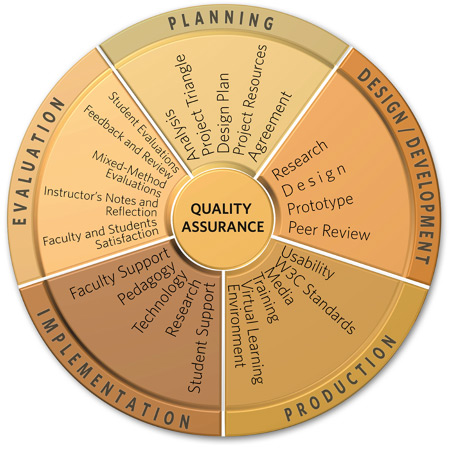Week 3: Overview
Some ideas about learning design and some collections of ideas for active online learning activities
Elements of Quality
Engaging your students and keeping them connected to the course and learning effectively takes a combination of good design and effective facilitation. The following approaches to quality of design and accessibility identify some important elements that you can think about as you continue to build your plan for a unit of learning, and start designing a selected prototype learning activity.
Two Canadian Approaches to Quality
- ecampusAlberta's Essential Quality Standards 2.0 (Note: Site shut down 2017 - see pdfs
- UBC's Instructional Design Community of Practice - see Afsaneh Sharif's Checklist - Online/Blended Learning Course Quality Checklist
eCampus Alberta's rubric includes seven areas of quality to think about when designing online courses:
- Web Design Standards: format, legibility, readability and navigation
- Course Information Standards: course outline/syllabus, instructor communication, learning outcomes, grading information, role of instructor and learners
- Writing Standards: bias, tone, citations, clear language, mechanics of writing
- Resources Standards: currency, authority, varied content resources, learner support
- Organization Standards: learning path, learning material, time commitment
- Pedagogy Standards: instructions, marking criteria, interactivity, instructional strategies, feedback
- Technology Standards: multimedia, orientation
 The UBC "Online and blended course quality checklist" includes a similar seven category structure.
The UBC "Online and blended course quality checklist" includes a similar seven category structure.
- General course information
- Course goals and learning outcomes
- Assessment
- Course materials
- Learner engagement
- Course technology
- Learner support
While the checklist approach is straightforward and easy to apply to a review of course design, the rubric provides a sense of levels of achievement in each area.
Using Quality as a Planning Tool
As you continue to build your Unit Plan and start to design your protoype learning activity, you may want to use some of the underlying values of these two approaches to guide your development:
- strive for clarity in writing, in layout
- help the learner to find what they need to know - easily
- make sure the "pieces" of your plan connect or align - is there a recognizable path from stated outcomes to planned learning activities and potential assessments?
- choose technologies that support the learning, are easy to access and use
- make sure your plan and activity include a sense of time - when they need to be started and completed and estimates of time for the instructor and the learner
References:
Note: eCampusAlberta closed in 2017; pdfs are available from the Athabasca University Library - two selected files are stored in SCoPE. - see
Quality Matters (2016) Higher Education Standards and Rubric - Retrieved from https://www.qualitymatters.org/qa-resources/rubric-standards/higher-ed-rubric
Royal Roads University, Centre for Teaching and Educational Technologies, (2013) Instructional Design Guidelines, Retrieved from http://ctet.royalroads.ca/ctet-instructional-design-guidelines
Sharif, Afsaneh (2014) Online and blended course quality checklist, Quality assurance designing quality online course, Creative Commons Attribution Share-alike 1.0. Retrieved from http://wiki.ubc.ca/images/2/25/OnlineQualityCheckList_SiteFinal_Sep2016.pdf